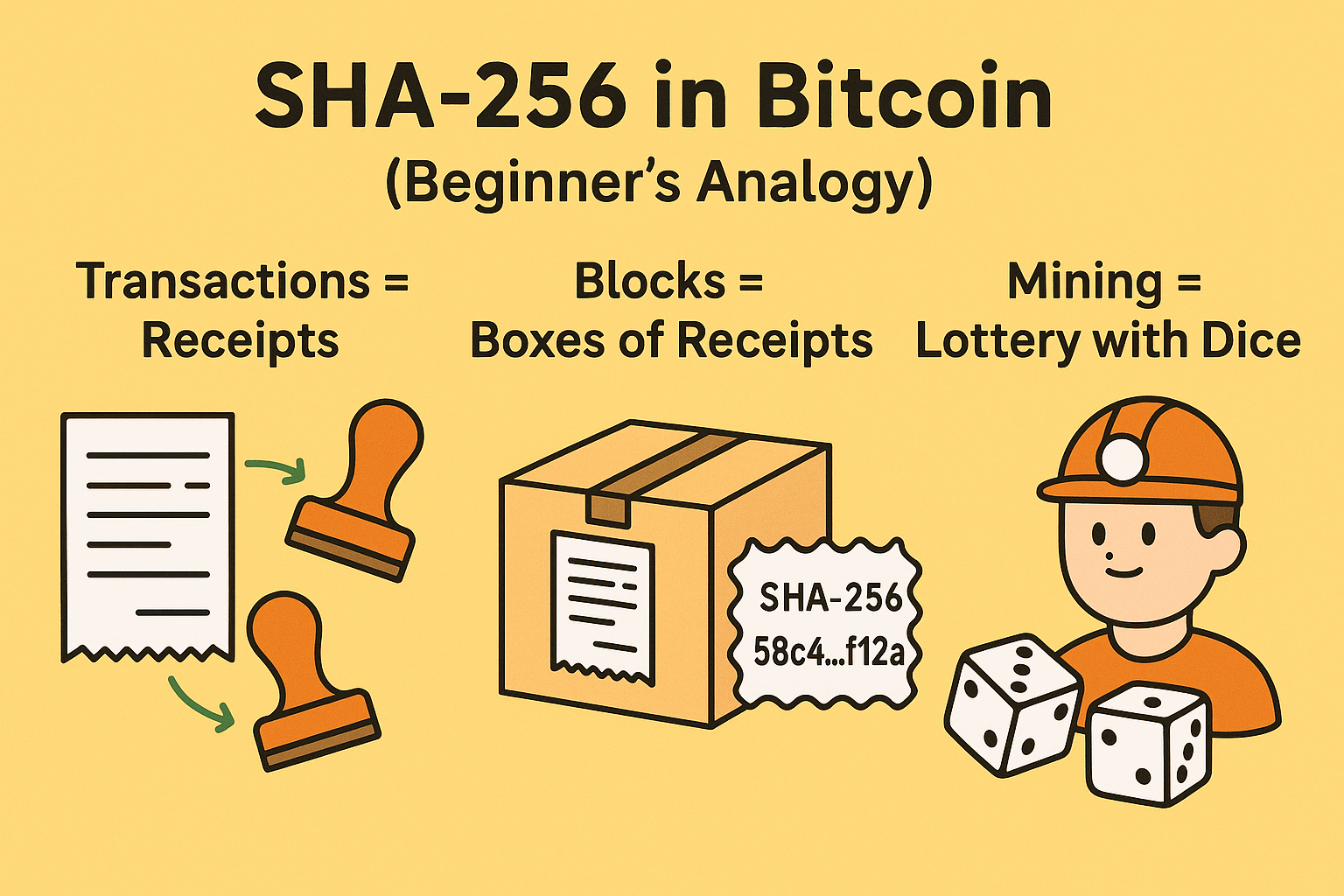What Is SHA-256 in Bitcoin?

SHA-256 in Bitcoin
Bitcoin’s security and trust don’t come from people or banks. They come from math.
At the heart of that math is SHA-256, a cryptographic hash function.
Let’s break it down:
What SHA-256 Is
- SHA stands for Secure Hash Algorithm.
- 256 means the output is always 256 bits long (that’s 64 characters in hexadecimal).
- It’s like a blender for data: no matter what you throw in (a tiny message or a huge file), SHA-256 spits out a fixed-size “fingerprint.”
Why Bitcoin Uses It
- Block Hashing
Each block in the blockchain has a header (like a summary). This header gets fed into SHA-256 twice (this is called double SHA-256), producing the block’s unique ID. Change even a single digit in the block, and the hash completely changes. - Mining (Proof of Work)
Miners compete by tweaking a small part of the block header (the nonce) and running it through SHA-256 again and again. They’re trying to find a hash that starts with a certain number of zeros. The more zeros required, the harder the puzzle. This difficulty keeps Bitcoin secure and predictable. - Transaction Security
Transactions themselves are hashed. A collection of them is combined into a Merkle tree, which boils everything down into one final hash (the Merkle root). That root sits inside the block header, tying all transactions to the block.
Why It Matters
- Immutability: Once a block’s hash is set, changing anything inside would change the hash. Everyone would notice.
- Fairness: Mining uses SHA-256 to create a lottery—no one can cheat their way to the winning hash.
- Security: SHA-256 is designed to be one-way. You can’t reverse-engineer the input from the output, making Bitcoin tamper-resistant.
👉In short:
SHA-256 is the “digital glue” that holds Bitcoin together. It makes transactions trustworthy, mining fair, and the blockchain unchangeable.
SHA-256 in Bitcoin (Beginner’s Analogy)
Think of SHA-256 like a super-powered digital stamp machine.
- No matter what you feed into it—a tiny note or a whole book. It always stamps out a code of the exact same length.
- The stamp looks random, but it’s always the same for the same input. Change even one letter, and the stamp comes out totally different.
How Bitcoin Uses This Stamp
- Transactions = Receipts
Imagine every time you spend or receive Bitcoin. You get a digital receipt. SHA-256 stamps that receipt with a unique code so nobody can secretly change the details later. - Blocks = Boxes of Receipts
A bunch of receipts are packed into a box (a block). Before the box is sealed, SHA-256 stamps the box with a code. That stamp depends on everything inside. If someone tries to sneak in a fake receipt, the stamp won’t match anymore—and everyone can see it’s been tampered with. - Mining = Lottery with Dice
Miners are like players in a lottery. They keep rolling dice (actually, they keep stamping the block with SHA-256 over and over, changing little details each time). The goal is to get a stamp that starts with a special pattern, like “0000…”.- Finding that pattern takes a lot of tries, but it proves they did the work.
- The first miner to find it wins the right to add the new block and gets rewarded with Bitcoin.
Why This Matters
- Tamper-proof: You can’t change old receipts or boxes without breaking the stamp.
- Fair game: Everyone has the same chance in the mining lottery.
- Trust without people: The stamps (SHA-256) replace banks, referees, or middlemen.
👉In short:
SHA-256 is Bitcoin’s unbreakable stamp machine. It locks in transactions, seals blocks, and powers the mining lottery. It is making the whole system secure and trustworthy without needing a bank.